The new planting revolution involves human capital
By Paulo Cesar Ferreira, Technical Director of Geração Agro
In this edition of Revista Cultivar Máquinas we present a field test with the Horsch brand seeder, model Maestro Evolution 36.50, carried out in Barreiras, Bahia. This model is an evolution of the Maestro SW, previously sold in Brazil. The quality of German technology, in addition to the global concept, could be fully observed in this machine.
This series of Horsch machines is offered in versions with 24, 30, 36, 39 and 40 lines and spacings from 45cm to 60cm. However, 60cm spacing is only offered on the 30-line model, 45cm spacing is offered for the 24, 36, 39 and 40-line versions and 50cm spacing is offered on the 24 and 36-line models. Called Split Row, the 39-row version is recommended for growing cotton at 90cm spacing. In other cases, the customer can choose the desired spacing.
The model we had available for testing had 36 lines, with a spacing of 50cm, characterizing one of the most commercialized for regions with large areas of agricultural cultivation, such as the state of Mato Grosso and the Northeast region.
Although the initial design and technology are German, it went through a major tropicalization process to be commercialized in Brazil. Manufactured in Curitiba (PR), the model has a large nationalization of components, having been accredited in the BNDES Finame Program since 2017.
In addition to several technological innovations, the machine is characterized by being articulated and self-transportable. Articulated because it has a planting bar with sections that adapt to the undulations of the terrain and self-transportable because the bar can be collected from the side of the tank, reducing the machine's transport width to 3,20m.
The seed deposit has approximately 9.000 liters of capacity, holding approximately 7.000kg of soybean seeds. This quantity refers to approximately seven big bags of 1.000kg each. It is recommended to add graphite, already in the reservoir, to improve movement at the exit of the seeds. In the Maestro Duo version, the tank is split, with a division of 2.000 liters for seed and 7.000 liters for fertilizer.

Horsch has a series of seeders with 12 to 18 rows, the Maestro Kompass, which is only sold in the version with fertilizer and seed, aimed at smaller areas, where this system of fertilization together with sowing is most used.
As a requirement for the seeder to function properly, the tank lids are locked and sealed with rubber to prevent air leakage from the seed transport system. Furthermore, the Maestro Evolution makes it possible to share microgranulated fertilizers or even small seeds during the sowing operation, through an auxiliary tank with a capacity of 600 liters placed on the left side of the main tank.
Without a doubt, the biggest innovation offered by this machine and the one that has the most impact at first glance is its very constitution. Consisting of a large capacity tank and, behind it, a planting bar with a configuration similar to that of a sprayer. The planting bar is formed by two or three sections, depending on the model; In models with 30, 36, 39 and 40 lines, the central part is fixed, known as bock and made up of 12 lines, and the two side sections are articulated, closing over the tank when in transport. The 36-line machine we tested has three sections, two on the sides with 12 lines each and one in the center, divided into two halves of six lines each.
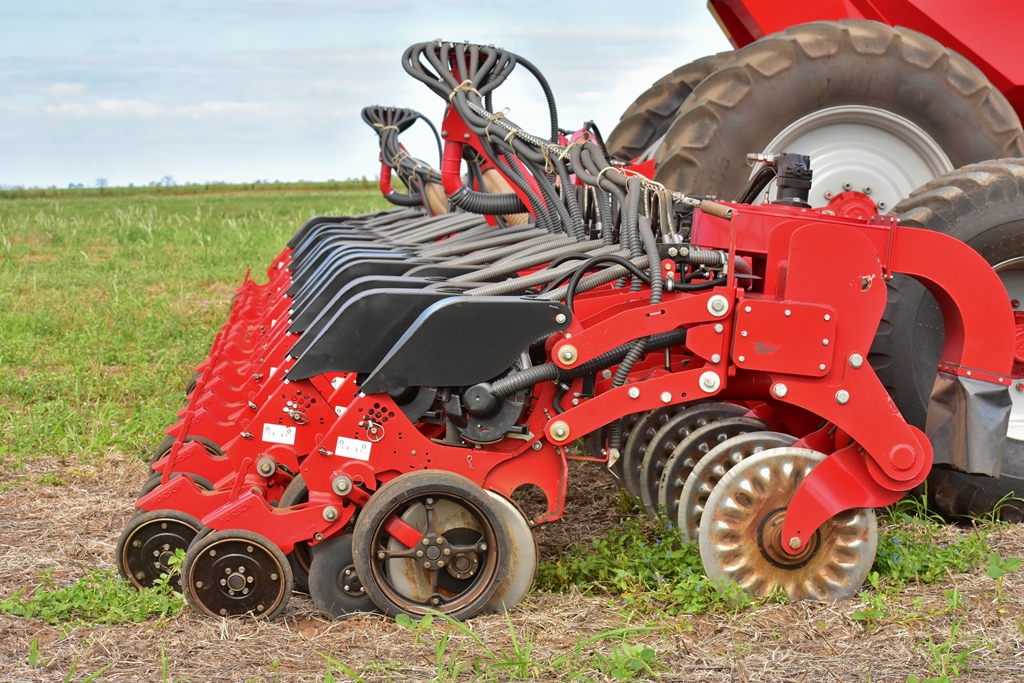
As expected, the independence of the bar in relation to the deposit generates the need to use a complex system of transferring weight to the bar, so that the pressure is sufficient to open the sowing furrow, control the depth of sowing and closing the furrow. And in this sense, this machine offers us an exceptional technological solution. Everything was thought out, predicted and implemented in order to achieve precision and uniformity in the sowing process. Firstly, there is a system for transferring weight from the tank to the lines, using two hydraulic cylinders, one on each lower side of the tank. Subsequently, at the bar line, a side piston transfers the weight to the central frame with pressures of 120bar to 125bar and another complementary hydraulic cylinder transfers around 65bar from the central frame to the side sections.
To complete the transfer of weight to the lines, the manufacturer provided each line with a small piston in the individual pantographic frame, which provides a vertical force downwards in the order of 150kgf to 330kgf and which can be adjusted from inside the tractor cabin, depending on ten out of ten kgf. As an important technical detail, the project includes a curiosity that denotes care and technical rigor. As the lines have a gap of 20cm between them, to improve the flow of the vegetation cover material (straw), the lever arm is alternately different, so the manufacturer placed different diameters of the cylinder rod, to compensate the pressure in the lines more long.
To open and close the furrow, the system begins with cutting the straw, which is done with a 20-inch diameter cutting disc, in the model according to the customer's needs. An innovative system for regulating the pressure and angle of attack of the disc uses the rotation of the disc support and an unprecedented pressure mechanism using rubber, placed between the metal parts, which works together with the hydraulic system.
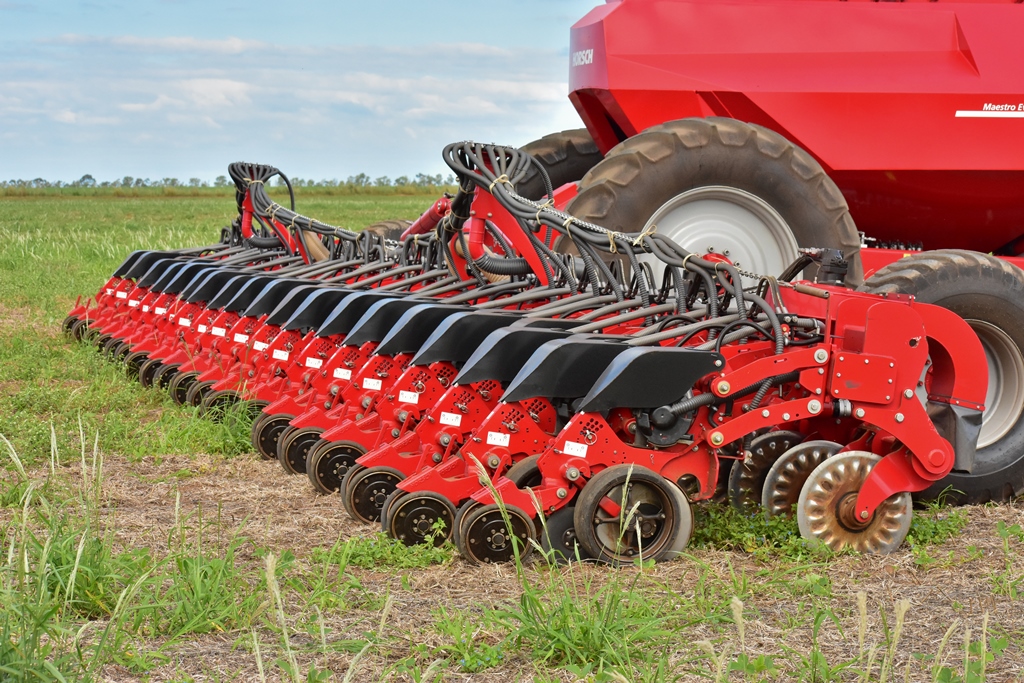
The opening of the seed deposition furrow is made with a pair of 16-inch diameter discs. The seed is deposited between the discs. Next to the furrowing discs there are two depth control wheels that can be adjusted to provide different depths, varying from 0,60 to 0,60 centimeters. The base of these wheels may contain lips or have a smooth surface, depending on the type of soil. Depth adjustment starts from the minimum value of 1,5cm and increases by 0,60cm with each subsequent hole. It is also possible to adjust the working position of the wheels, moving them further apart or closer together.
Just behind the discs, the project includes a seed fixing wheel, which prevents the formation of air pockets and also positions the seed within the furrow.
At the end of the line, two compacting and covering wheels are also arranged, which have the function of giving the furrow profile, whether flatter or more wavy, in relation to the average plane of the ground surface. The working angle can be adjusted simply.
In addition to the machine's force transfer system, other ways of adding weight to the planting bars can be used, such as ballasting with metal weights on the bar and adding water to the tires that support the tank and the bar itself, with guidance from the machine. factory engineering.
Perhaps among all the systems adopted in the design of the Horsch seeder model Maestro Evolution 36.50, the seed dosing system was the one that surprised us the most and impressed us with its quality. Air enters the tank through a snorkel-type pickup in the upper front part of the tank, feeding the SOD turbine that pressurizes the tank and drives the seeds to the lines. The elevated position of the snorkel prevents the entry of dust that is in suspension and in greater concentration the closer to the ground surface.
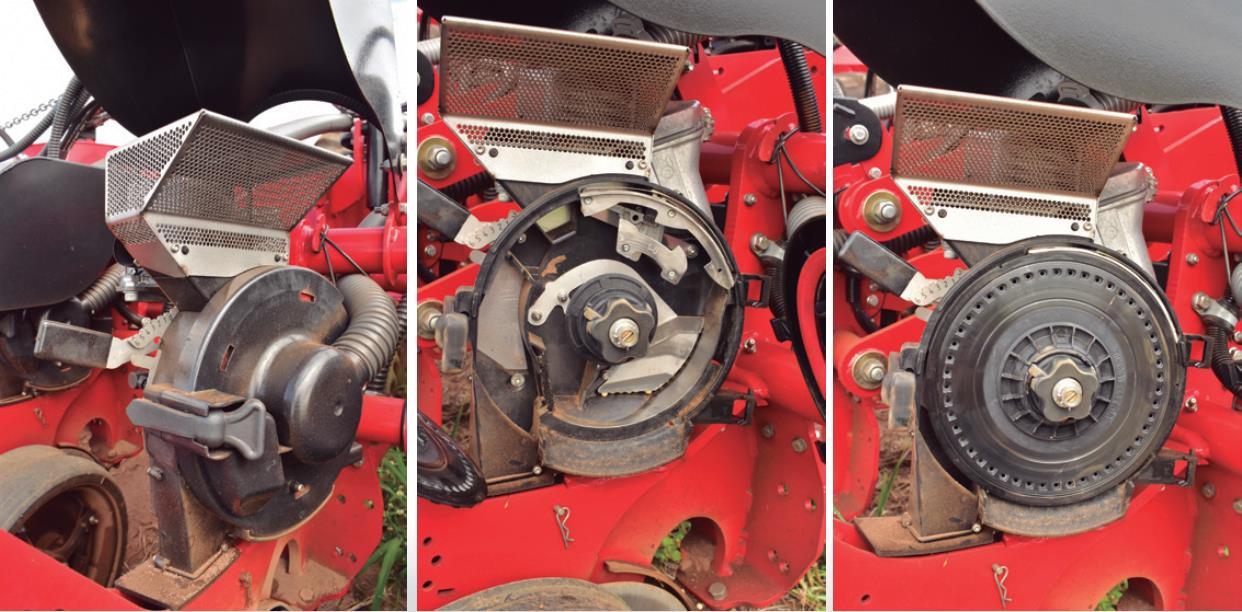
The air passes through the SOD turbine, which has 10ccm for machines with 39 or 40 lines and 6ccm for machines with up to 36 lines. It is hydraulically driven and is positioned at the base of the deposit's inverted pyramid. To adjust the working pressure there is a by pass valve and a pressure gauge. The air flow and seed output hoses exit behind the machine and, through positive pressure, the air mass and seeds reach the doser. When they reach this point, the flow of seeds enters from the outside of the doser, and through negative pressure or suction (controlled by the vacuum turbine), the seeds adhere to the 20,2cm diameter disc.
The project provides for a device called Extra-Power, in order to improve the distribution of power to the machine and help the electrical power necessary for proper operation to be supplied. In smaller machines, it consists of two cables that bring current directly from the tractor battery, and in models above 39 rows there is an electricity generator mounted on the turbine itself.
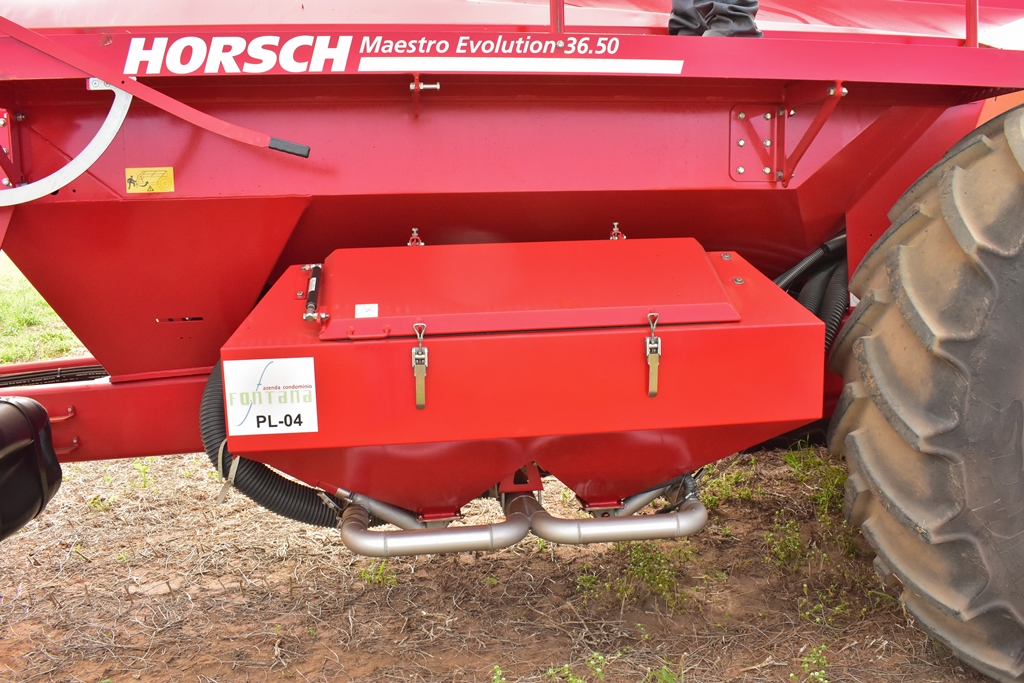
Electrically driven dosers called Horsch AirVac consist of a vertical pneumatic disc and a compact, low-consumption electric motor. The seeds are sucked in by the vacuum and stick to the hole only by this negative pressure.
The disc space comprises three distinct areas, in the first area the grains enter through the gate at the bottom and as the disc rotates, the seeds begin to be loaded onto the disc. When rotating, the disc elevates the seeds to the second area, subjecting them to the work of the singulator, which eliminates doubles and prevents failures from occurring. The third area is the seed drop zone, in which the air suction is cut off and the seed is sent to the exit through a small conductive tube. The disc cell is subjected to the work of an extractor wheel that eliminates possible impurities adhered to the holes of the dosing disc.
For the safety of the entire electrical system, there is a fuse box that protects the electric motors that drive the dosers, positioned above the doser line and on the bar structure.
If all the technology put into the machine's various systems wasn't enough, the manufacturer has introduced electronic items that will certainly make a difference for producers to improve the quality of the sowing operation. During the field test we took the opportunity to learn about these differences.

Similar to what happens in major brands, there is full adoption of the Isobus standard, with a Horsch Touch 800 monitor. As an option, the user can purchase software activation, and can then use all precision agriculture resources, such as application of variable rates of multiproducts, small seeds, microgranules, using prescription maps. It is also possible for the Horsch monitor screens to be used in the interface of the tractor that is pulling the machine. This second alternative makes it possible to centralize all diagnostics and functionalities on a single monitor, that of the tractor. Another function that the software presents is the passage corridor system, which allows the sprayer trail lines to be automatically disconnected according to the gauge and boom width of the sprayer. In the lines next to the trail it is possible to compensate with up to 30% more grain, optimizing the use of seeds.
We verified that Horsch placed a doppler speed measuring radar in the header of the machine. This makes it possible to read the real speed of the machine for those users who have a tractor without on-board electronics. By configuration, we saw that if the tractor has its own speed measurement capabilities, this radar can be deactivated, selecting the speed that comes from the tractor's technology for control.
One great feature we saw on the machine is the planting simulation functionality. Without the need to move the machine, the user can set a speed, open the gate that allows the flow of seeds and simulate the operation of the machine's dosing system, predicting the quantity of seeds that will fall when it is actually working. .
We also note that the machine has flow and seed mass sensors, which can be adapted to the type of seed, the quantity of large seeds and the weight of small seeds applied to the line.
The machine's hitch to the tractor's drawbar is equipped with a height adjustment system, with a mechanical jack to adjust the hitch and a safety chain. The product development team in the field measured the weight incident on this point and dimensioned it to meet the safety and maximum performance of the tractor.
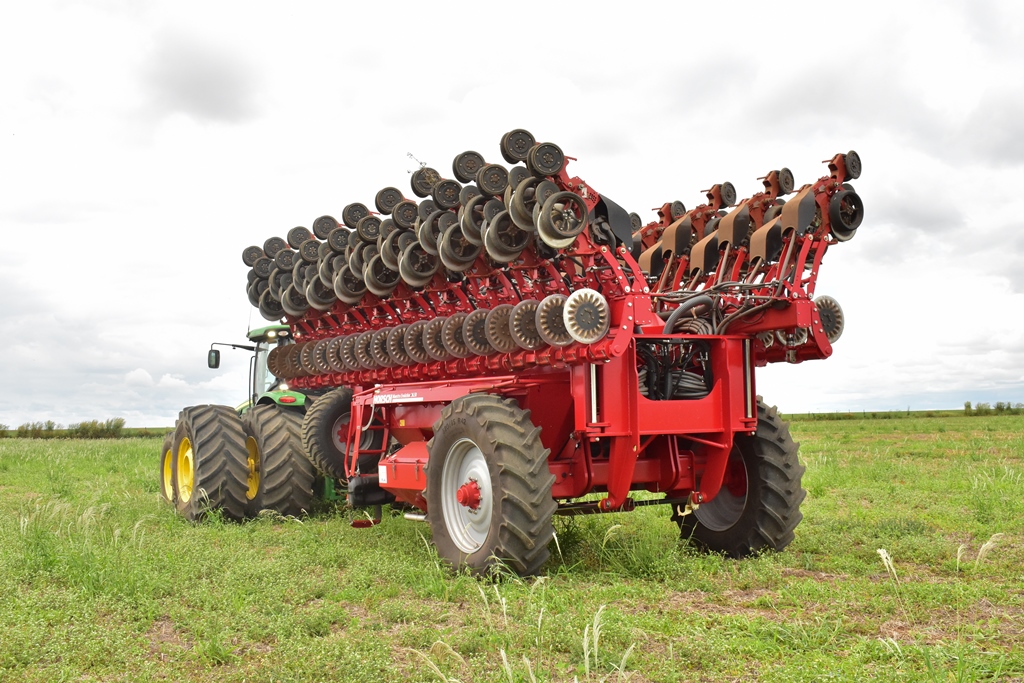
The hose terminals of the hydraulic system that drive the hydraulic cylinders that are coupled to the tractor's remote control valves (VCR) are ergonomic, with a rubberized support and with flow direction identification, to identify the coupling position, pressure and return, something unheard of until now in the machines tested for Cultivar Máquinas magazine. There are three connection pairs, plus free return. There is also an Isobus connection socket and an extra supply from the electrical system, as the dosing system uses the energy that comes from the tractor's battery.
For machine transport and movement operations, there is a field-to-road valve, which protects the system from strong pressure fluctuations. This valve is located next to the hydraulic connection hose support.
The gauge of the main wheelsets can be adjusted from 3,10 to 3,70 meters. This variation and adjustment can be done hydraulically from inside the tractor cabin, moving it at an approximate speed of 2km/h. The two tires that support the weight of the tank are of the radial type, measuring 520/85R42, while those that support the weight of the planting bar are specification 550/60-22,5.
For many supply and maintenance tasks it is necessary to access the tank, which is why this model has a large platform, equipped with handholds and handrails, which can be accessed by a ladder placed on the front side of the seed or fertilizer tank. It should be noted that, to comply with ergonomic standards and principles, the first step of the access ladder is flexible, with rubber supports.
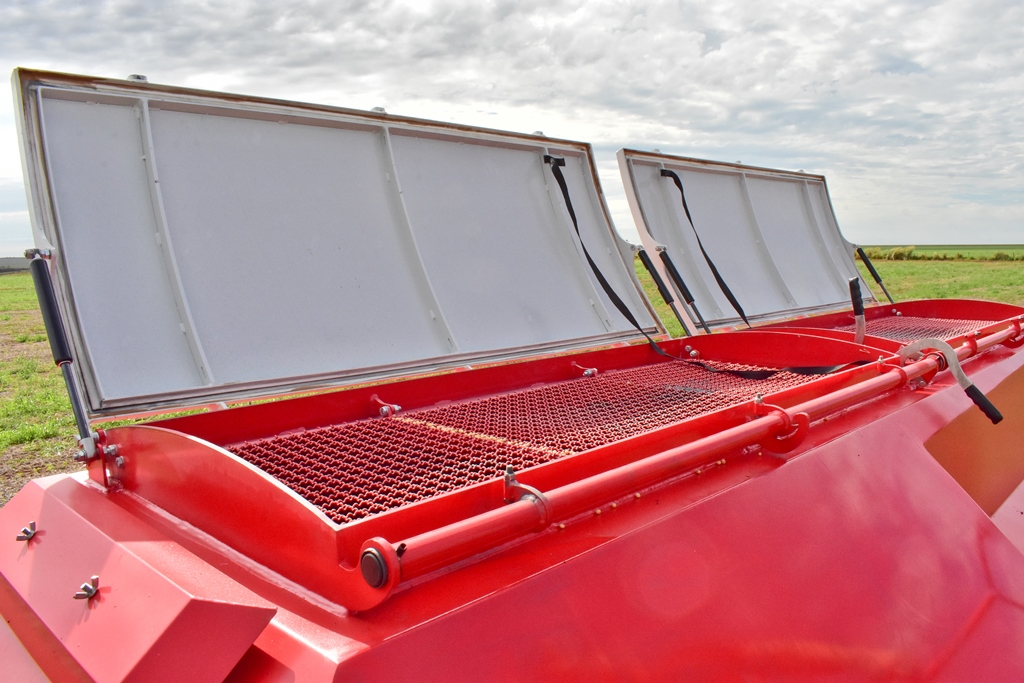
The platform has a non-slip floor and provides lateral access to the reservoir, which is protected by a removable metal mesh, which prevents people and objects from falling. In addition to these details, it appears that the machine has protections on all moving parts to prevent accidents during use.
The test of this machine was carried out on a customer's farm in the town of Placas, municipality of Barreiras, in Bahia. Barreiras is known as the Capital of Western Bahia, located in the Northeast region of the country, characterized by being an important economic center of the state and the region, mainly due to its structure and real estate potential, in addition to being one of the leading regions in Brazilian agribusiness. . As in several other regions of Matopiba, Barreiras is the country's most recent agricultural frontier and where farmers from different regions of Brazil converged from the 1980s onwards.
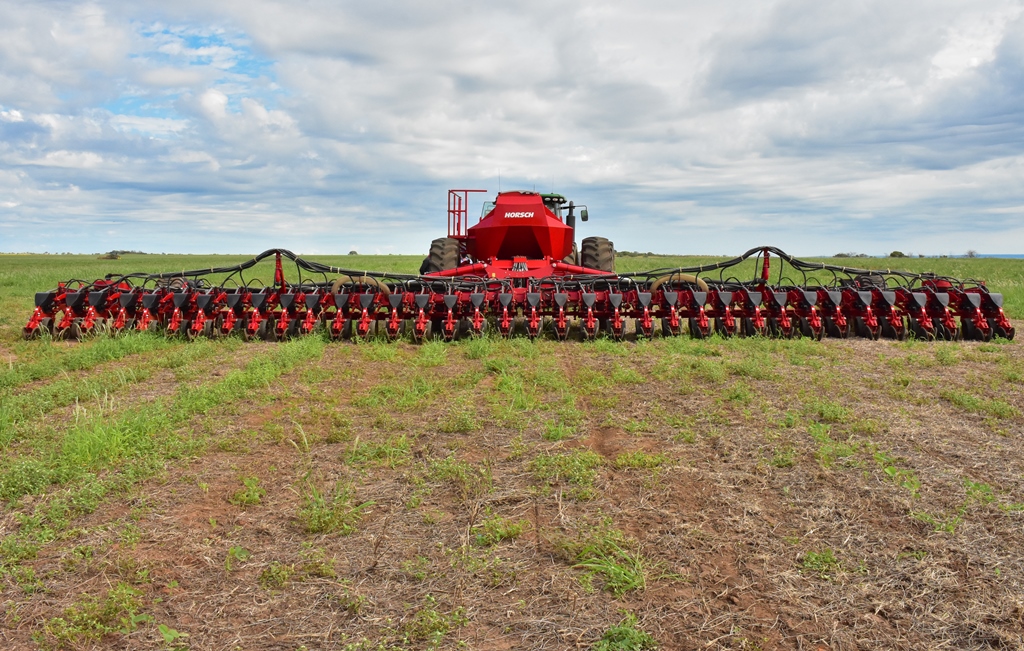
The area where we carried out the tests was covered with plant remains from previous soybean cultivation and the soil was a medium-textured Oxisol.
After adjusting and adapting the machine to the soil and seed used, carried out by the manufacturer's technical team, the machine was made available to our team to learn about its devices and operations, in addition to evaluating the work in the field.
The machine was being driven by a John Deere model 8400R tractor, with 400hp maximum power and dual front and rear wheels. Just like the seeder, this tractor also belonged to the customer and there was full integration of the electrical, hydraulic and logical systems.
For the field test, we scheduled a journey to recognize all the attributes and functionalities of the machine and evaluate the quality of the work. As for operation, even though it was a large seeding machine, we were impressed by the ease of headland maneuvers and the speed with which the hydraulic systems reacted as soon as they were activated (raising or lowering the machine).
The set was assembled with two monitors, the tractor and the seeder, and it was very easy to check the system and obtain information about the individual operation of the lines, so that the operator can check immediately when there is an interruption in the supply of the lines. and the quality of the operation.
We started at a speed of 6km/h in seventh gear, going through speeds of 8km/h, 10km/h and 12km/h in ninth, eleventh and twelfth gears at 2.160rpm, making several passes through the area.
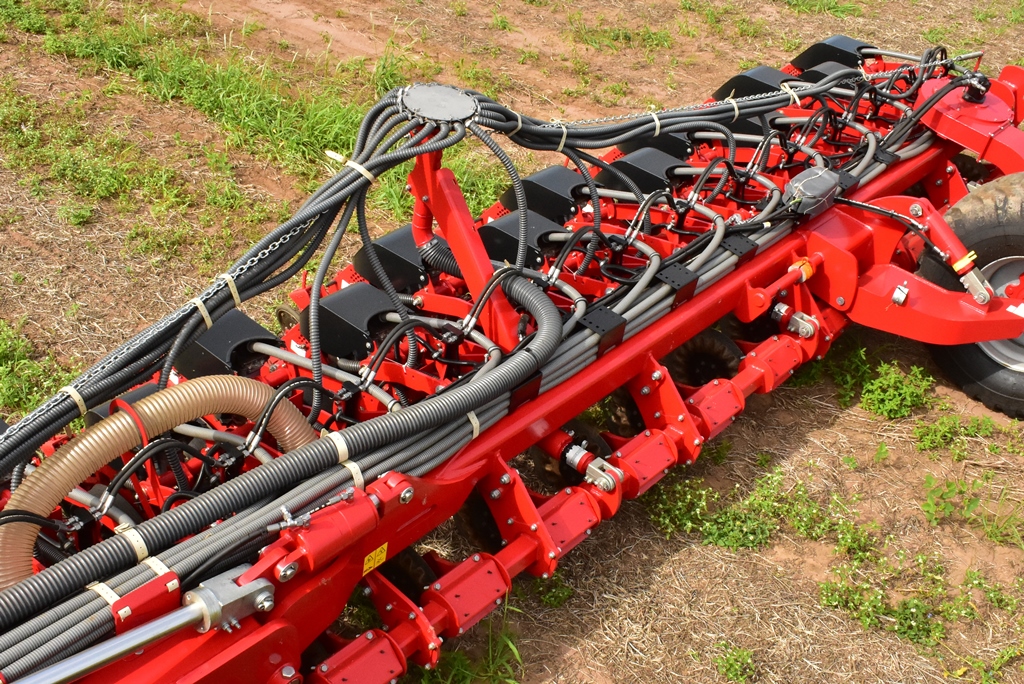
To evaluate the quality of the sowing operation, we chose to analyze the longitudinal distribution of seeds in the row and the sowing depth. The machine was adjusted to place a quantity of 200 thousand seeds per hectare at a spacing of 50 centimeters between rows, which resulted in 20 thousand linear meters and, consequently, in the deposition of ten seeds per meter, resulting in a reference spacing of 10 cm between one seed and another. We analyzed several points of a machine pass and found that out of 50 spaces analyzed, only one was considered double and none of the spaces were considered faulty. As for depth, we saw that the performance was excellent, with no irregularities or variations in what was predetermined in the adjustment. The company uses the coefficient of variation as a seeding quality criterion, in addition to evaluating the percentage of spacing classified as normal or within the reference range.
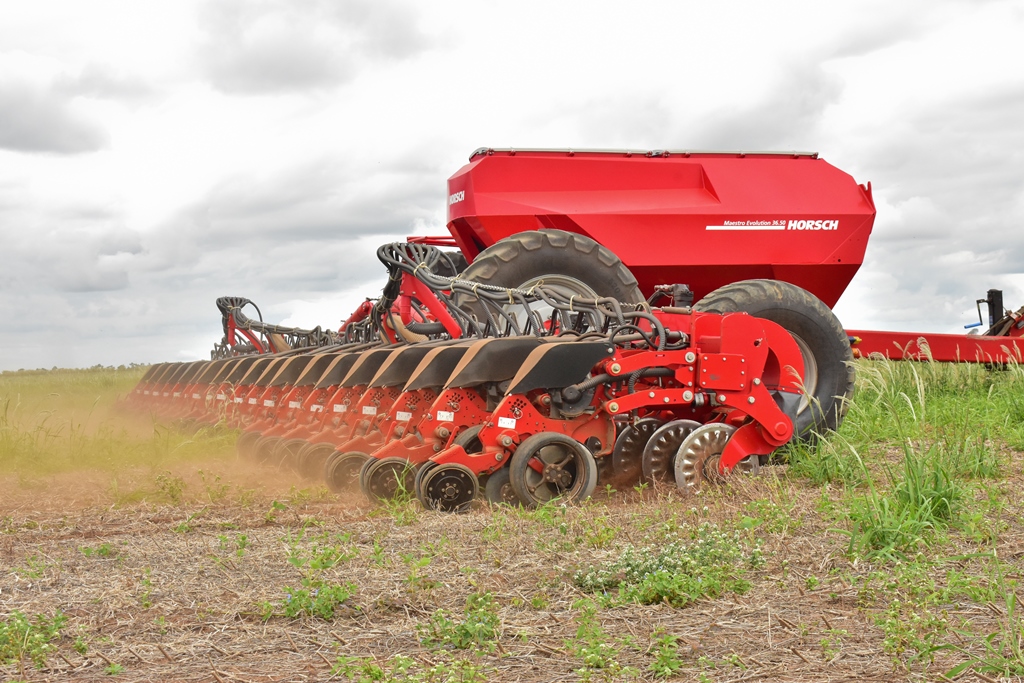
We also evaluate the response to commands to open and close the machine, converting the transport position into a work position and vice versa. We measured times between one minute and 17 seconds and one minute and 21 seconds for this operation. The combination of the work of the hydraulic cylinders that act in this task is truly impressive.
In short, we consider the experience of being able to test this machine and its innovative solutions in the sowing process to be fantastic. The most important points of this product are the articulation of the bar on the tank and the ease of transport, due to the reduction in width and accommodation of the bar on the central structure. We can also highlight as strong points, in our evaluation, the pneumatic system for transporting and dosing seeds, with the disc driven by electric motors.
The team that helped us throughout the day of testing was made up of consultant Giovani Pauls, who provides services for Horsch, supporting the technical and commercial team in training and delivering the machines to producers in the region. Born in Paraná and resident of Luís Eduardo Magalhães since 2004, Giovani demonstrated his knowledge of the region's agriculture and the machine we tested very well.
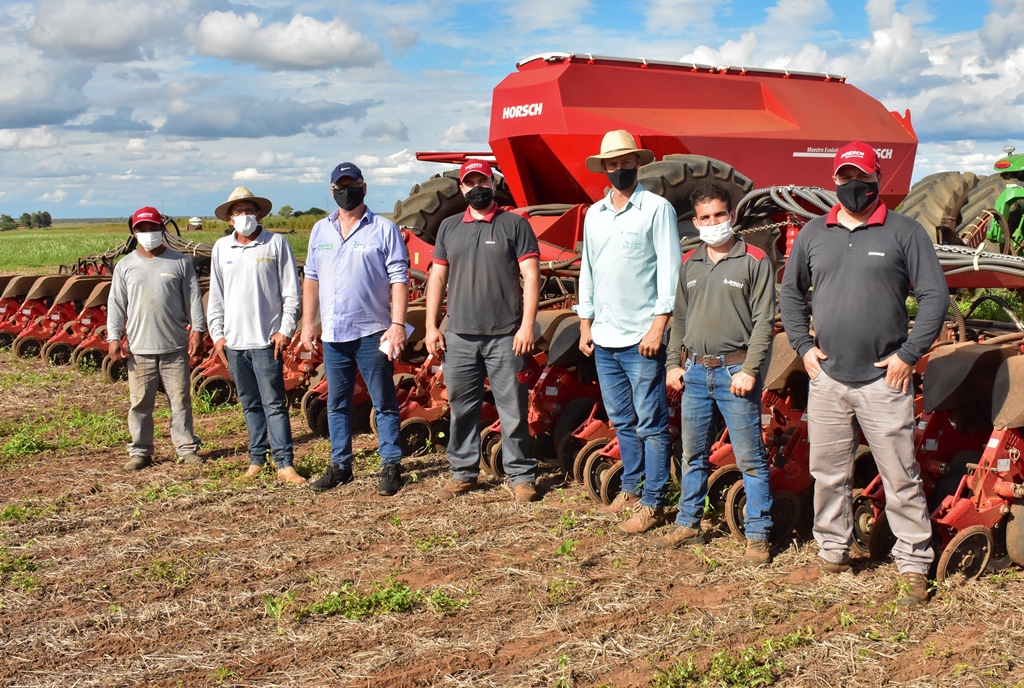
From Horsch, we were joined by engineer Bruno Zanchetin Hosoume, who works in product validation engineering in the field, and Samuel Barros, who is a specialist in Product Marketing for the brand. The two work on several fronts and accompany the brand's machines in their development and tropicalization to the agricultural systems used in different regions of the country. Horsch's Marketing Manager, Maik Penner, also accompanied us at different stages of the test. They mastered every detail that we asked for clarification from its origin and function.
Local staff, who had a relationship with the client, also accompanied us. Agricultural engineer Rosimar Barbosa Freitas Junior, who works in the after-sales area of the dealership Jaraguá Bahia Máquinas e Implementos Agrícolas LTDA, distributor of the Horsch brand. He is the one who knows all the solutions for adapting the machine to the ground and the system adopted in the region, having accompanied most of the machines that arrived. We also had the support and invaluable understanding for the time we were in the testing area from Mr. Sandro Cavalheiro, from Santa Catarina from Canoinhas and who is the farm's Operations Manager and had to interrupt other work to allow us to test the machine in this area.
You can get more information and prices from Maestro Evolution by clicking here.
Jose Fernando Schlosser,
Daniela Herzog and
Rubén Darío Collantes Veliz,
Nema - DER – UFSM

Receive the latest agriculture news by email